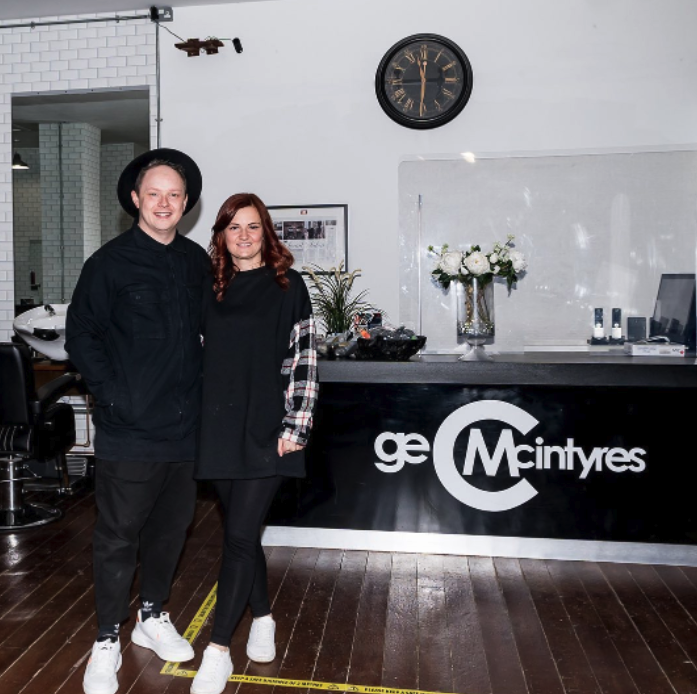Switching your pricing structure is a decision that requires reflection and an assessment of your current salon’s profitability and efficiency. If you’ve ever wondered why it might be a good idea to switch yours, you’re about to find out.
Time-based pricing
This pricing structure provides a straightforward, easy-to-implement, and comprehensive experience for clients. The premise is to charge your clients an inclusive hourly rate. This rate will increase or decrease depending on the experience level of the stylist.
Ella and Gavin McIntyre, a husband-and-wife team of hairdressers, opened G&E McIntyres in 2015. They initially began taking salon business courses, expanding their focus over time to eventually secure three British Hairdressing Business Awards, including Salon of the Year. But amidst success, their traditional à la carte pricing was no longer conducive to dependable profit margins and they felt a switch to time-based pricing was looking like an intelligent solution.
The all-inclusive à la carte
The all-inclusive à la carte pricing strategy that they were operating on reflects various services or techniques that are set with standard prices and inclusions. For example, a full head of highlights would have a set price for each level of a stylist at G&E. “We had always priced services based on a law of averages—in the traditional, à la carte way,” said Gavin. It’s a simple and straightforward pricing structure to understand, however, it could at times deliver unpredictable margins and didn’t account for undercharges due to long, thick hair and overcharges due to short, thin hair.
The argument for salons wanting time-based pricing
Of course, every salon is unique and the reasoning behind switching pricing structures can vary. Some of the most common reasons why salons make the switch include:
- Unpredictable margins: overcharging or undercharging can be present on a daily basis, making it hard to establish dependable profits month over month and year over year.
- Irregular profitability: your current pricing structure isn’t producing profits that you’re excited about and you feel there’s an opportunity for growth.
- Transparency for clients: A simpler menu can make it easier to establish an open dialogue about the product, service, and labour costs.
Innovation awaits
With a celebrated streak of success, Ella and Gavin weren’t interested in slowing down any time soon. Keen to collaborate with industry innovators, they were introduced to Vish.
“We started working together almost overnight when Vish was nominated for Innovation of the Year by the British Hairdressing Awards the same year we won for Customer Service,” explains Gavin McIntyre. “We met Vish Managing Director for EMEA, Tom Bentley-Taylor, at the awards. Tom explained what Vish does, we took a closer look, and within a matter of weeks we transformed how we managed our colour inventory and usage, and ultimately, our pricing.” The intelligent three-part colour management system leverages innovation and technology and empowers salons to take control of their colour business.
Saying adiós to à la carte
When the opportunity arose to make a shift to time-based pricing, the McIntyres were ready to take the leap.
We’re now on the verge of time-based pricing, rolling out shortly. With the pandemic, we saw the amount of product used and time needed to serve clients who come in semi-annually and determined that they can’t be charged the same as clients who come in regularly. With Vish, we now have tools to build stability and transparency into our pricing and profitability,” said Gavin.
Because we now charge for services based on an hourly rate, our pricing is accurate and fair. It’s better for our guests, our stylists, and our business.
-Gavin
Building the buy-in
Before making the switch to time-based pricing, Ella and Gavin spent a lot of time coaching their stylists to understand the structure and set targets for average revenue per hour.
“The software tracks what is being brought in against their targets and we have financial meetings every two weeks, and quarterly reviews to discuss performance with the team. Now, with time-based pricing, their income per hour will be more stable and consistent. Everything is priced to hit those goals—guesswork is eliminated,” said Gavin.
Monitor and measure your success
Monitor average cost per service, average waste per service, and more with the help of the Vish Dashboard. These insights help salon owners make data-driven decisions that ultimately retain profits and streamline the pricing process.
“Our new salon security blanket is in the hourly charge strategy. With the help of Vish, we’ve built in our overhead and made time-based pricing a win for the client, stylist, and business,” says Gavin. Since using Vish, G&E McIntyres managed to reduce their waste from 37% to 8%, yielding a decrease in product costs per service and colour costs.
Flipping the switch on pricing
His advice to salon owners and Vish users thinking about making the switch?
“Time-based pricing works because we now have the tools and technology to make it simple. I believe it will improve our salon and give us a completely different point of view to not only charge clients but run our businesses in the future.” Furthermore, the receptiveness from clients has reinforced the notion that it was the right decision for their salon.
He adds “Time-based pricing takes away the element of surprise for clients, eliminates confusion and can build trust. Consumers today value clarity and knowing what they are buying and the ‘why.’”
